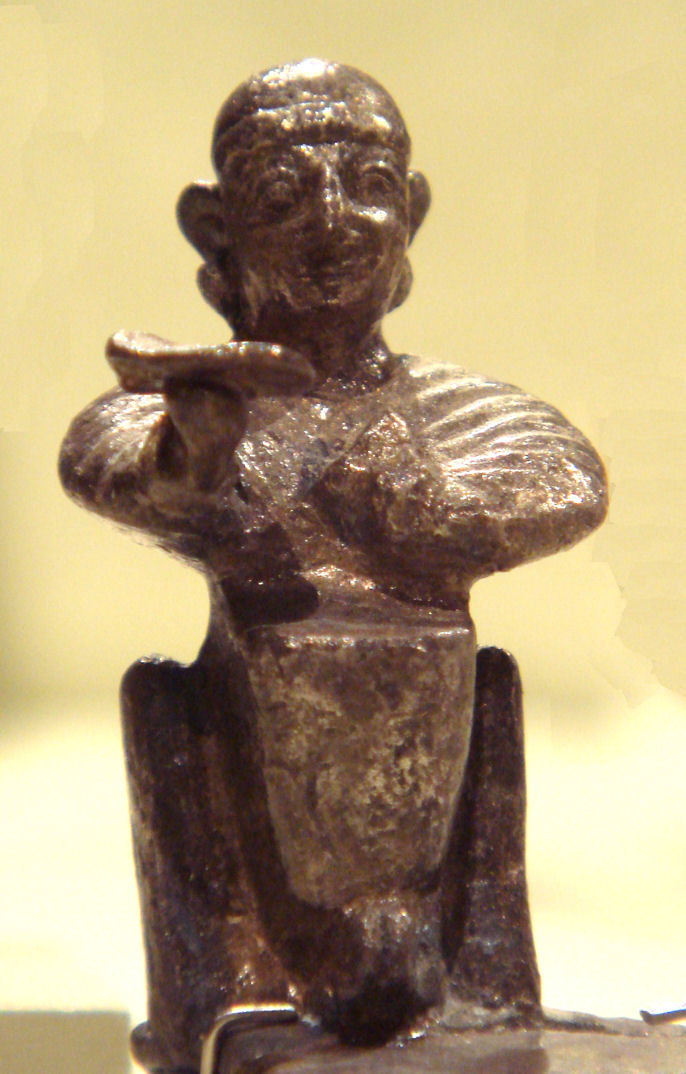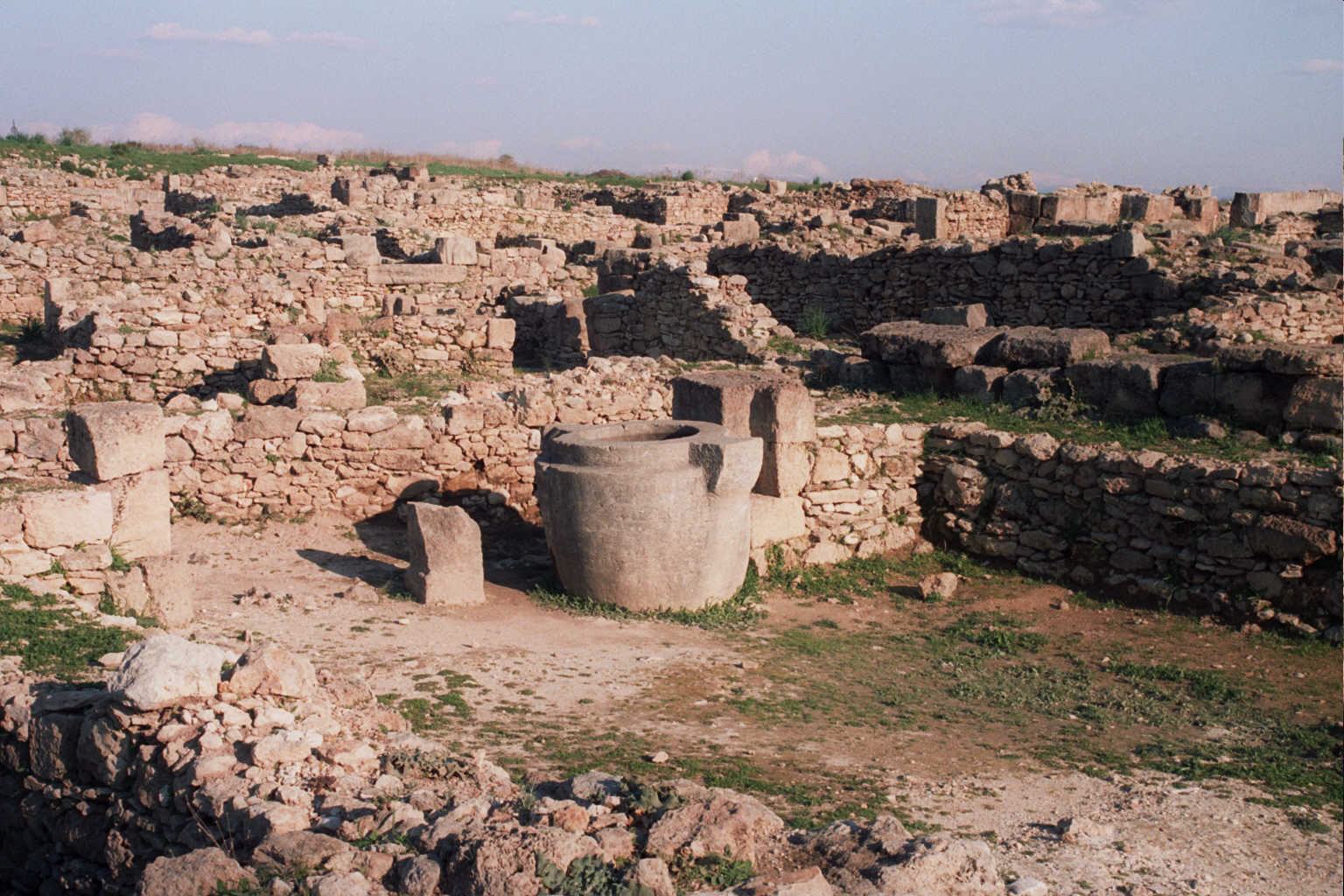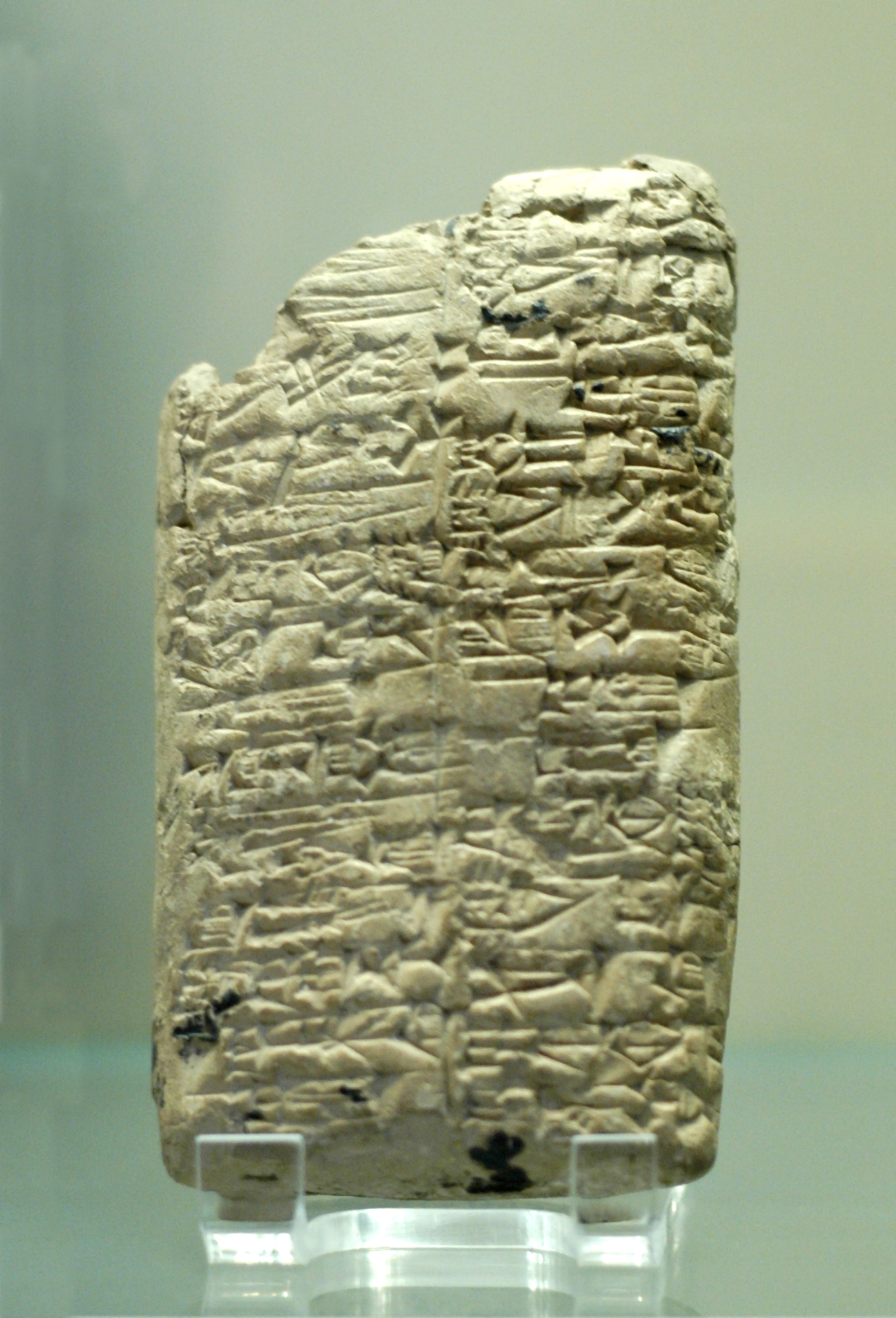|
Elkunirša
Elkunirša (in Hittite: '' Del-ku-ni-ir-ša'' or '' Del-ku-ni-ir-ša-aš'') is a Hittite god of a Canaanite origin. The god is known from a myth in Hittite, believed to be originated from Canaan, as well as one ritual tablet. Myth of Elkunirša Elkunirša's myth was discovered only in Hittite, but scholars are certain its origin is Canaanite. The Canaanite origin is learned by the names of the deities in the myth. Elkunirša is a Hittite version of , known from ''ʾ''Azatiwada inscrioption, and other Canaanite and Aramaic instances. Ašertu is ''ʾ''Ašerah. Two other divine names appear in ideograms, one – DU – belongs to the weather god, here identified as Baʿal, and the other – DIŠTAR – is identified here as ʿAnat or ʿAštart. The myth also bears Canaanite stylitic features. There is also a reference to the land Amurru and ''a-na- ..' (probably Ḫana or ʿAnat (city)). The text was unearthed in several fragments, probably all belonging to one tablet, ... [...More Info...] [...Related Items...] OR: [Wikipedia] [Google] [Baidu] |
Anat
Anat (, ), Anatu, classically Anath (; ''ʿnt''; ''ʿĂnāṯ''; ; ; Egyptian language, Egyptian: ''wikt:ꜥntjt, ꜥntjt'') was a goddess associated with warfare and hunting, best known from the Ugaritic texts. Most researchers assume that she originated in the Amorites, Amorite culture of Bronze Age upper Mesopotamia, and that the goddess Ḫanat, attested in the texts from Mari, Syria, Mari and worshiped in Anah, a city sharing her name located in Suhum, should be considered her forerunner. In Ugarit, Anat was one of the main goddesses, and regularly received offerings, as attested in texts written both in the local Ugaritic language and in Hurrian language, Hurrian. She also frequently appears in myths, including the ''Baal Cycle'' and the ''Epic of Aqhat''. In the former, she is portrayed as a staunch ally of the weather god Baal, who assists him in his struggle for kingship, helps him with obtaining the permission to obtain a dwelling of his own, and finally mourns a ... [...More Info...] [...Related Items...] OR: [Wikipedia] [Google] [Baidu] |
Hittite Mythology And Religion
Hittite mythology and Hittite religion were the religious beliefs and practices of the Hittites, who created an empire centered in Anatolia from . Most of the narratives embodying Hittite mythology are lost, and the elements that would give a balanced view of Hittite religion are lacking among the tablets recovered at the Hittite capital Hattusa and other Hittite sites. Thus, "there are no canonical scriptures, no theological disquisitions or discourses, no aids to private devotion". Some religious documents formed part of the corpus with which young scribes were trained, and have survived, most of them dating from the last several decades before the final burning of the sites. The scribes in the royal administration, some of whose archives survive, were a bureaucracy, organizing and maintaining royal responsibilities in areas that would be considered part of religion today: temple organization, cultic administration, reports of diviners, make up the main body of surviving te ... [...More Info...] [...Related Items...] OR: [Wikipedia] [Google] [Baidu] |
El (deity)
El is a Northwest Semitic word meaning 'god' or 'deity', or referring (as a proper name) to any one of multiple major ancient Near Eastern deities. A rarer form, ''ila'', represents the predicate form in the Old Akkadian and Amorite languages. The word is derived from the Proto-Semitic *ʔil-. Originally a Canaanite deity known as ''El'', ''Al'' or ''Il'' the supreme god of the ancient Canaanite religion and the supreme god of East Semitic speakers in Early Dynastic Period of Mesopotamia. Among the Hittites, El was known as Elkunirša ( ). Although El gained different appearances and meanings in different languages over time, it continues to exist as ''El-'', ''-il'' or ''-el'' in compound proper noun phrases such as Elizabeth, Ishmael, Israel, Samuel, Daniel, Michael, Gabriel (Arabic: Jibra'il), and Bethel. Linguistic forms and meanings Cognate forms of El are found throughout the Semitic languages. They include Ugaritic , pl. ; Phoenician pl. ; Hebrew , pl. ... [...More Info...] [...Related Items...] OR: [Wikipedia] [Google] [Baidu] |
Asherah
Asherah (; ; ; ; Qatabanian language, Qatabanian: ') was a goddess in ancient Semitic religions. She also appears in Hittites, Hittite writings as ''Ašerdu(š)'' or ''Ašertu(š)'' (), and as Athirat in Ugarit. Some scholars hold that Asherah was venerated as Yahweh's consort in ancient Kingdom of Israel (Samaria) , Israel and Kingdom of Judah , Judah, while other scholars oppose this. Name Etymology Some have sought a common-noun meaning of her name, especially in Ugaritic appellation ''rabat athirat yam'', only found in the Baal Cycle. But a homophone's meaning to an Ugaritian doesn't equate an etymon, especially if the name is older than the Ugaritic language. There is no hypothesis for ''rabat athirat yam'' without significant issues, and if Asherah were a word from Ugarit it would be pronounced differently. The common NW Semitic meaning of ''šr'' is "king, prince, ruler." The NW Semitic root ''ʾṯr'' (Arabic ) means "tread". Grammar The -ot ending "Asherot" ... [...More Info...] [...Related Items...] OR: [Wikipedia] [Google] [Baidu] |
Canaanite Gods
Canaanite religion or Syro-Canaanite religions refers to the myths, cults and ritual practices of people in the Levant during roughly the first three millennia BC. Canaanite religions were polytheistic and in some cases monolatristic. They were influenced by neighboring cultures, particularly ancient Egyptian and Mesopotamian religious practices. The pantheon was headed by the god El and his consort Asherah, with other significant deities including Baal, Anat, Astarte, and Dagon. Canaanite religious practices included animal sacrifice, veneration of the dead, and the worship of deities through shrines and sacred groves. The religion also featured a complex mythology, including stories of divine battles and cycles of death and rebirth. Archaeological evidence, particularly from sites like Ugarit, and literary sources, including the Ugaritic texts and the Hebrew Bible, have provided most of the current knowledge about Canaanite religion. Sources and history Knowledge a ... [...More Info...] [...Related Items...] OR: [Wikipedia] [Google] [Baidu] |
Wake (ceremony)
A wake or visitation is a social gathering associated with death, held before a funeral. Traditionally, a wake involves family and friends keeping watch over the body of the dead person, usually in the home of the deceased. Some wakes are held at a funeral home or another convenient location. The wake or the viewing (funeral), viewing of the body is a part of death rituals in many cultures. It allows one last interaction with the dead, providing a time for the living to express their thoughts and feelings with the deceased. It highlights the idea that the loss is borne by the whole community and is a way of honoring the deceased member. The emotional tone of a wake is sometimes seen as more positive than a funeral due to the socially supportive atmosphere and the focus on the life rather than the death of the deceased. Origin The term originally referred to a late-night prayer vigil but is now mostly used for the social interactions accompanying a funeral. While the modern us ... [...More Info...] [...Related Items...] OR: [Wikipedia] [Google] [Baidu] |
Third-person Narrative
Narration is the use of a written or spoken commentary to convey a story to an audience. Narration is conveyed by a narrator: a specific person, or unspecified literary voice, developed by the creator of the story to deliver information to the audience, particularly about the plot: the series of events. Narration is a required element of all written stories (novels, short stories, poems, memoirs, etc.), presenting the story in its entirety. It is optional in most other storytelling formats, such as films, plays, television shows and video games, in which the story can be conveyed through other means, like dialogue between characters or visual action. The narrative mode, which is sometimes also used as synonym for narrative technique, encompasses the set of choices through which the creator of the story develops their narrator and narration: * ''Narrative point of view, perspective,'' or ''voice'': the choice of grammatical person used by the narrator to establish whether or no ... [...More Info...] [...Related Items...] OR: [Wikipedia] [Google] [Baidu] |
Northwest Semitic Languages
Northwest Semitic is a division of the Semitic languages comprising the indigenous languages of the Levant. It emerged from Proto-Semitic in the Early Bronze Age. It is first attested in proper names identified as Amorite in the Middle Bronze Age. The oldest coherent texts are in Ugaritic, dating to the Late Bronze Age, which by the time of the Bronze Age collapse are joined by Old Aramaic, and by the Iron Age by Sutean and the Canaanite languages (Hebrew, Phoenician/ Punic, Edomite and Moabite). The term was coined by Carl Brockelmann in 1908,The Semitic Languages: An International Handbook, Chapter V page 425 who separated Fritz Hommel's 1883 classification of |
Desert
A desert is a landscape where little precipitation occurs and, consequently, living conditions create unique biomes and ecosystems. The lack of vegetation exposes the unprotected surface of the ground to denudation. About one-third of the land surface of the Earth is arid or Semi-arid climate, semi-arid. This includes much of the Polar regions of Earth, polar regions, where little precipitation occurs, and which are sometimes called polar deserts or "cold deserts". Deserts can be classified by the amount of precipitation that falls, by the temperature that prevails, by the causes of desertification or by their geographical location. Deserts are formed by weathering processes as large variations in temperature between day and night strain the Rock (geology), rocks, which consequently break in pieces. Although rain seldom occurs in deserts, there are occasional downpours that can result in flash floods. Rain falling on hot rocks can cause them to shatter, and the resulting frag ... [...More Info...] [...Related Items...] OR: [Wikipedia] [Google] [Baidu] |
Underworld
The underworld, also known as the netherworld or hell, is the supernatural world of the dead in various religious traditions and myths, located below the world of the living. Chthonic is the technical adjective for things of the underworld. The concept of an underworld is found in almost every civilization and "may be as old as humanity itself". Common features of underworld myths are accounts of living people making journeys to the underworld, often for some heroic purpose. Other myths reinforce traditions that the entrance of souls to the underworld requires a proper observation of ceremony, such as the ancient Greek story of the recently dead Patroclus haunting Achilles until his body could be properly buried for this purpose. People with high social status were dressed and equipped in order to better navigate the underworld. A number of mythologies incorporate the concept of the soul of the deceased making its own journey to the underworld, with the dead needing to be ... [...More Info...] [...Related Items...] OR: [Wikipedia] [Google] [Baidu] |
Wine
Wine is an alcoholic drink made from Fermentation in winemaking, fermented fruit. Yeast in winemaking, Yeast consumes the sugar in the fruit and converts it to ethanol and carbon dioxide, releasing heat in the process. Wine is most often made from grapes, and the term "wine" generally refers to grape wine when used without any qualification. Even so, wine can be made fruit wine, from a variety of fruit crops, including plum, cherry, pomegranate, blueberry, Ribes, currant, and Sambucus, elderberry. Different varieties of grapes and Strain (biology), strains of yeasts are major factors in different styles of wine. These differences result from the complex interactions between the Biochemistry, biochemical development of the grape, the reactions involved in fermentation, the grape's growing environment (terroir), and the wine production process. Many countries enact legal appellations intended to define styles and qualities of wine. These typically restrict the geographical origin ... [...More Info...] [...Related Items...] OR: [Wikipedia] [Google] [Baidu] |
Clay Tablet
In the Ancient Near East, clay tablets (Akkadian language, Akkadian ) were used as a writing medium, especially for writing in cuneiform, throughout the Bronze Age and well into the Iron Age. Cuneiform characters were imprinted on a wet clay tablet with a stylus often made of Reed (plant), reed (reed pen). Once written upon, many tablets were dried in the sun or air, remaining fragile. Later, these unfired clay tablets could be soaked in water and recycled into new clean tablets. Other tablets, once written, were either deliberately fired in hot kilns, or inadvertently fired when buildings were burnt down by accident or during conflict, making them hard and durable. Collections of these clay documents made up the first archives. They were at the root of the first library, libraries. Tens of thousands of written tablets, including many fragments, have been found in the Middle East. Most of the documents on tablets that survive from the Minoan civilization, Minoan and Mycenaean ... [...More Info...] [...Related Items...] OR: [Wikipedia] [Google] [Baidu] |






